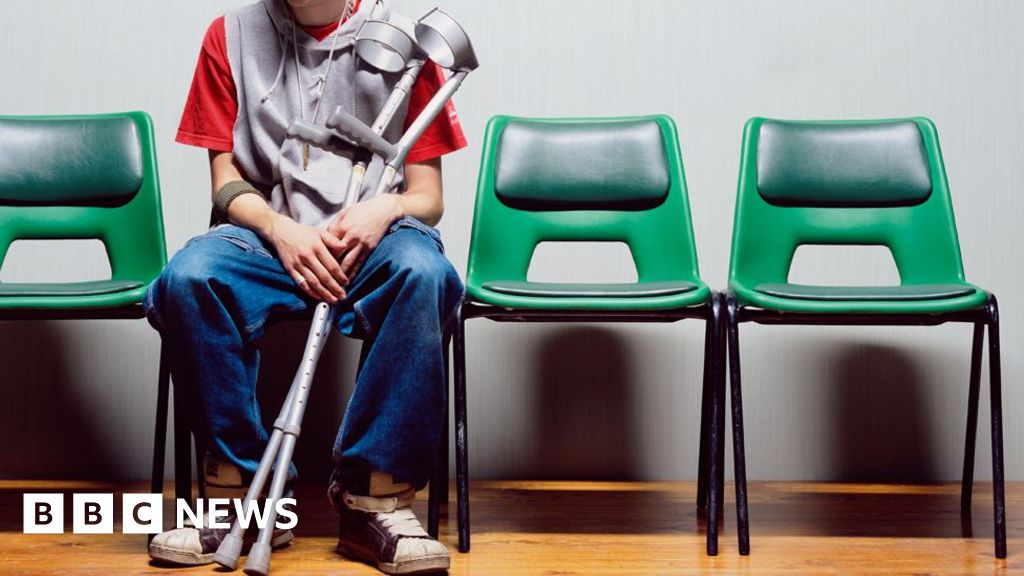Health Correspondent, North West
 PA Media
PA MediaNearly 39,000 patients spent more than a day in North-West England’s A&Es because there were no hospital beds for them, North West has discovered.
Statistics show of those patients, more than 1,000 patients waited longer than three days, often spending much of that time on a trolley in the corridor.
The Royal College of Emergency Medicine (RCEM) has warned that nationally, the situation could be costing thousands of lives.
NHS England said they were dealing with rising demand and staff were working extremely hard but they understood how long waits impacted on patients.
Colin Gray was one of those patients. The 80-year-old spent 40 hours in A&E at Arrowe Park Hospital in Wirral after arriving by ambulance on 30 December with heart problems.
“I was in corridors from Monday until Thursday evening in the same clothes that I’d arrived in and probably in the same bedding on the trolley,” he said
“It was just a mass of trolleys… the queue seemed to go on forever.”
At the time, the trust which runs the site said the department, like most, was extremely busy.
“To maintain patient safety, we prioritise the patients in most urgent need of emergency care and unfortunately this may have meant a longer than expected wait for other patients especially those awaiting hospital admission,” they said.
The hospital was just a week away from declaring a critical incident because of the pressures on A&E.
The Royal Liverpool, Aintree and Whiston Hospitals also declared critical incidents in that week.
The term is used when pressures are so great that they cannot deliver those critical services and they need support from outside.
Mr Gray said many of the trolleys were attended by ambulance paramedics who had brought them there.
“I found it demoralising, frustrating… there’s constant noise from other patients, comings and goings of beds being moved,” he said.
“You’re lying there, you have nothing to occupy your mind other than your thoughts of your condition.
“You’re thinking: ‘Where is this going? How long is this going on for?'”
The NHS releases monthly data on how many patients have waited longer than 12 hours to be admitted to hospital but this gives no indication of actual wait time.
North West sent a Freedom of Information request to every hospital with an adult A&E in the region, asking for details of waits longer than 24, 36, 72, and 96 hours over the course of 2024, and the longest wait time for any one patient.
Every trust sent back a full reply apart from two; Wrightington, Wigan and Leigh, which runs the Royal Albert Edward Infirmary, and Mersey and West Lancashire, which runs Whiston and Southport hospitals.
Both said they were unable to access the information within the time. North West is challenging both decisions.
From the rest, the results were staggering.
In all, 38,561 patients waited more than 24 hours to be given a bed in a ward, of which 12,452 waited more than 36 hours – a day and a half.
Some of those patients waited for days – 1,000 for longer than three days, and 225 for longer than four.
The longest wait was just over a week.
 /Gill Dummigan
/Gill DummiganIn mid-December, I was at the Royal Preston reporting on the so-called “Quad-demic” of flu, Covid, norovirus and the respiratory virus RSV.
At that time, I was told that some patients were waiting more than two days to be admitted.
The consultant heading A&E, Dr Michael Stewart, told me at the time the situation was not helping patients recover.
“The lights don’t switch off, the noise doesn’t go down, it doesn’t become peaceful at night,” he said.
“It’s not a good place for people to rest and start recuperating and recovering once that initial stage is over.
“We look after them, we bring the meals in, they’re looked after by the staff, we get the beds for them, but still it’s not the space they need to be in.”
There are marked differences across the region.
In Lancashire and South Cumbria, 13,708 patients waited more than 24 hours, while in Merseyside and Cheshire that figure was 18,248 – nearly three times that of Greater Manchester’s 6,605.
The difference was even more pronounced with very long waits.
In Greater Manchester, the number of patients waiting longer than three days was 102, and all but 13 of those were patients waiting to be transferred to a bed in a mental health trust.
Patients with a mental health crisis often end up waiting for days while a bed is found elsewhere, and the problem is particularly acute in Greater Manchester.
By contrast the number of waits of more than three days in Cheshire and Merseyside was more than five times the Greater Manchester total, 592 patients, and only 45 of those related to mental health transfers.
Lancashire and South Cumbria were in the middle with 306 patients, 188 of them mental health patients.
One trust, the Countess of Chester, stood out with 498 patients waiting more than three days for a bed and 70 waiting more than four days.
A spokesperson for that trust said they were committed to reducing long waits and had now eliminated all waits above 72 hours.
“We have plans in place to reduce waiting times further so patients will not have to wait more than 48 hours for a hospital bed,” they said.
“Our aim is that by the end of February 2025, no patients will wait more than 36 hours for a bed, and we are determined to reduce this further.”
 /Gill Dummigan
/Gill DummiganFor patients suffering physical rather than mental illness, both totals were more than the rest of the North West put together
The main issue for all of these places is an inability to discharge patients from wards and free up beds.
Often it is linked to a lack of available social care support or community nursing.
This means that people, particularly the frail elderly, are unable to safely be sent home and a lack of supported accommodation means that there is nowhere else for them to go.
In January, a national study by the Royal College of Nursing found nine out of 10 nurses believed the current situation was putting patient safety was at risk.
The RCEM said corridor care is “unacceptable and dangerous”, while its president
Dr Adrian Boyle added that scientific studies showed long stays in A&E could harm patients.
“For every 72 people who stay more than 12 hours, there’s one additional death,” he said.
“We’re in a ridiculous situation where we’re making people sicker before we’re making them better.”
Dr Boyle said if there was no fix for corridor care, “I’m afraid we’re going to lose staff and we’ll be here again next year having the same conversations about avoidable deaths”.
In a statement, NHS England North West Medical Director Dr Michael Gregory said demand had risen in every part of the NHS in recent years, leading to ongoing pressure, particularly in the winter months.
“We know this impacts on the experiences of patients, and we know we are currently not meeting the high standards to which the NHS rightly aspires,” he said.
“At the same time, we know we are doing well for a large majority of the people we care for and we are very grateful to our NHS staff who continue to work extremely hard in challenging circumstances.
“We will continue… to make improvements to reduce waiting times within urgent and emergency care services and to improve access to primary care and mental health services.
“NHS providers are also working with their partners to ensure the right care is in place to support patients to leave hospital when they are ready to do so safely, ensuring hospital beds are readily available to those who need them most.”
Back in Wirral, Colin Gray is now recovering at home but said his experience has put him off going to the emergency department again.
“I can’t think of a situation where I would accept going back to A&E,” he said.
“I really can’t.”




